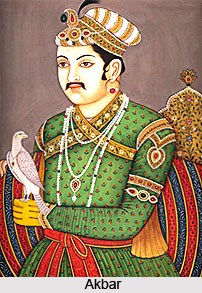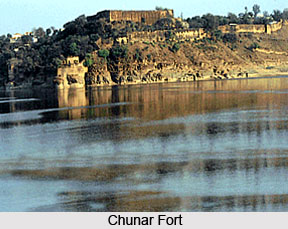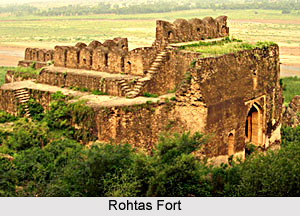 In Bihar province, the most important work of Akbar`s time was in the hill fort of Rohtas. In 1576, Akbar`s troops had captured Rohtas from rebel Afghan forces and had utilised the hill fort, some 45 km in circumference, as a garrison pivotal in controlling the rest of eastern India. As such, architecture in Bihar during Akbar comes down as a crucial point of time in Mughal architecture in Bihar, which was pivotal to the ruling and administration of the Mughal Empire from far-off Delhi/Agra.
In Bihar province, the most important work of Akbar`s time was in the hill fort of Rohtas. In 1576, Akbar`s troops had captured Rohtas from rebel Afghan forces and had utilised the hill fort, some 45 km in circumference, as a garrison pivotal in controlling the rest of eastern India. As such, architecture in Bihar during Akbar comes down as a crucial point of time in Mughal architecture in Bihar, which was pivotal to the ruling and administration of the Mughal Empire from far-off Delhi/Agra.
Although the fort of Rohtas had served as an important fort under the Suri dynasty (made legendary by the daring debonair Sher Shah Suri), the Mughals had developed a different portion of the fort. There actually exists a palace at Rohtas Fort that Raja Man Singh (one of a Hindus in the court of the Muslim Akbar and one of his highest ranking amirs) had erected, but it was not the first Mughal building in the fort. A mosque had been built in 1578, only two years after the fort became strictly Mughal in art after Sher Shah. Indeed, architecture in Bihar during Akbar grossly had revolved around the highly invincible and unassailable Rohtas Fort, shrouded with legends. After all, the mosque in Rohtas was the first Mughal monument in all Bihar provinces. Built by an Akbar loyalist, Habash Khan, who had died defending Rohtas against renegade Mughal amirs and Afghan rebels, the mosque is similar in appearance to the Jami mosque constructed on the hill thirty-five years earlier by Haibat Khan, one of Sher Shah Suri`s leading generals.
 Both of the mentioned mosques adhere to a single-aisled three-bayed rectangular plan. Differences that lie till today are indeed slight. The central pishtaq of the Mughal mosque is lower and its facade bears intricately carved panels, recalling similar work on a gate at the Chunar Fort under Akbar. Although the Mughal mosque in Rohtas resembles the earlier Afghan one, situated approximately 3 km away, it bears an inscription over the central entrance arch that might be interpreted as a poignant statement of Mughal supremacy. Opening with the Quranic phrase, "With God`s help victory is imminent," most of this Persian inscription refers to Akbar`s victories and concludes with an appeal, in Arabic, to "deliver this good news to believers." Considering the wobbly political situation during that time, the inscription is mostly interpreted as a proclamation of Mughal authority over rebels in Bihar. Rebellious intervention was one major factor which was most commonplace during emperor`s Akbar`s time and his architectural circulation in eastern India. Yet, overlooking every kind of hardship, architecture in Bihar during Akbar was handsomely accomplished by the honest nobility and patronaged amirs who were brought under the good-will of the emperor regularly from the Mughal court.
Both of the mentioned mosques adhere to a single-aisled three-bayed rectangular plan. Differences that lie till today are indeed slight. The central pishtaq of the Mughal mosque is lower and its facade bears intricately carved panels, recalling similar work on a gate at the Chunar Fort under Akbar. Although the Mughal mosque in Rohtas resembles the earlier Afghan one, situated approximately 3 km away, it bears an inscription over the central entrance arch that might be interpreted as a poignant statement of Mughal supremacy. Opening with the Quranic phrase, "With God`s help victory is imminent," most of this Persian inscription refers to Akbar`s victories and concludes with an appeal, in Arabic, to "deliver this good news to believers." Considering the wobbly political situation during that time, the inscription is mostly interpreted as a proclamation of Mughal authority over rebels in Bihar. Rebellious intervention was one major factor which was most commonplace during emperor`s Akbar`s time and his architectural circulation in eastern India. Yet, overlooking every kind of hardship, architecture in Bihar during Akbar was handsomely accomplished by the honest nobility and patronaged amirs who were brought under the good-will of the emperor regularly from the Mughal court.
 However, in association with Bihar`s architecture during Akbar and the mass connection with the fort of Rohtas, a single mosque is not enough to suggest an urban setting, the mosque which was erected by Habash Khan. There were, however, other Akbari structures on the Rohtas hill, which indicate the presence of a permanent and continuous large population. By far the largest and most important of these is the palace of Raja Man Singh. Numerous smaller buildings, mostly tombs, remain in the vicinity of the palace and Habash Khan`s mosque. Amongst these are a chattri and an unusual wall mosque, serving as the tomb of Saqi Sultan, who had expired in 1579-80, before he could attain the title khan, which he greatly coveted. Further testimony to the fort`s large population is a service town at the foot of the hill. It was - and still is - called `Akbarpur`, after the then-ruling monarch. Thus, although relatively inaccessible and robustly fortified, Rohtas Fort appears to have functioned as a major urban centre as long as it remained a significant administrative centre.
However, in association with Bihar`s architecture during Akbar and the mass connection with the fort of Rohtas, a single mosque is not enough to suggest an urban setting, the mosque which was erected by Habash Khan. There were, however, other Akbari structures on the Rohtas hill, which indicate the presence of a permanent and continuous large population. By far the largest and most important of these is the palace of Raja Man Singh. Numerous smaller buildings, mostly tombs, remain in the vicinity of the palace and Habash Khan`s mosque. Amongst these are a chattri and an unusual wall mosque, serving as the tomb of Saqi Sultan, who had expired in 1579-80, before he could attain the title khan, which he greatly coveted. Further testimony to the fort`s large population is a service town at the foot of the hill. It was - and still is - called `Akbarpur`, after the then-ruling monarch. Thus, although relatively inaccessible and robustly fortified, Rohtas Fort appears to have functioned as a major urban centre as long as it remained a significant administrative centre.
While Rohtas was an important military headquarters, it was the cities of Hajipur, Patna and Munger, situated on the Ganges, as well as Bihar Sharif, the traditional administrative centre of Bihar and long a site of tremendous religious importance, that were the major urban settlements, likewise serving as the most strategic architectural governance in Bihar during Akbar. Inscriptions indicate Akbari-period building activity in all of them, excluding Patna.
Hajipur, situated at the confluence of the Gandak River and Ganges, across from Patna, was considered the key to north Bihar. The city had been the land-holding of Said Khan, who on three separate occasions had served as the governor of Bihar. Here in 1586-87, during Said Khan`s first period of governorship, his brother Makhsus Khan had erected a mosque, the second recognised Mughal mosque in Bihar, a classic instance of Mughal architecture of Bihar during Akbar. Although Makhsus Khan`s mosque`s facade and entrance gate were seriously ravaged in the 1934 earthquake, the original layout is intact and the interior appears little changed. The mosque`s adherence to olden Afghani style mosques as well as its Bengali forms, for instance, the minbar (a pulpit in the mosque where the Imam (leader of prayer) stands to present sermons) and curved cornice of the entrance gate, hints a reliance upon local designers, a particular Mughal architectural feature that has come down since the age of Babur. The link with Bengal in particular is not surprising since Hajipur, often in Bengali hands, was a decisive naval headquarters under the pre-Mughal Husain Shahi dynasty. Thus in Bihar, except for Raja Man Singh`s outstanding patronage, Mughal architectural design remained primarily `conservative`.






































